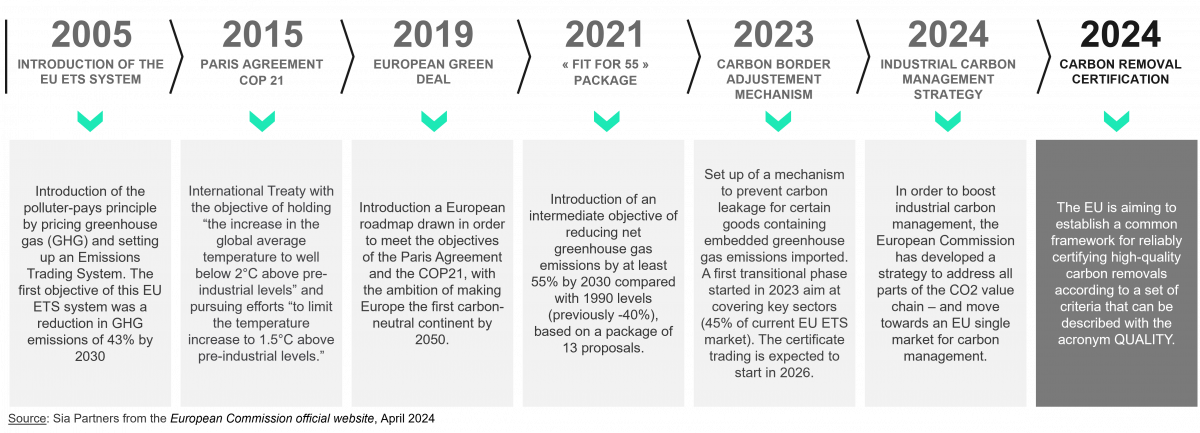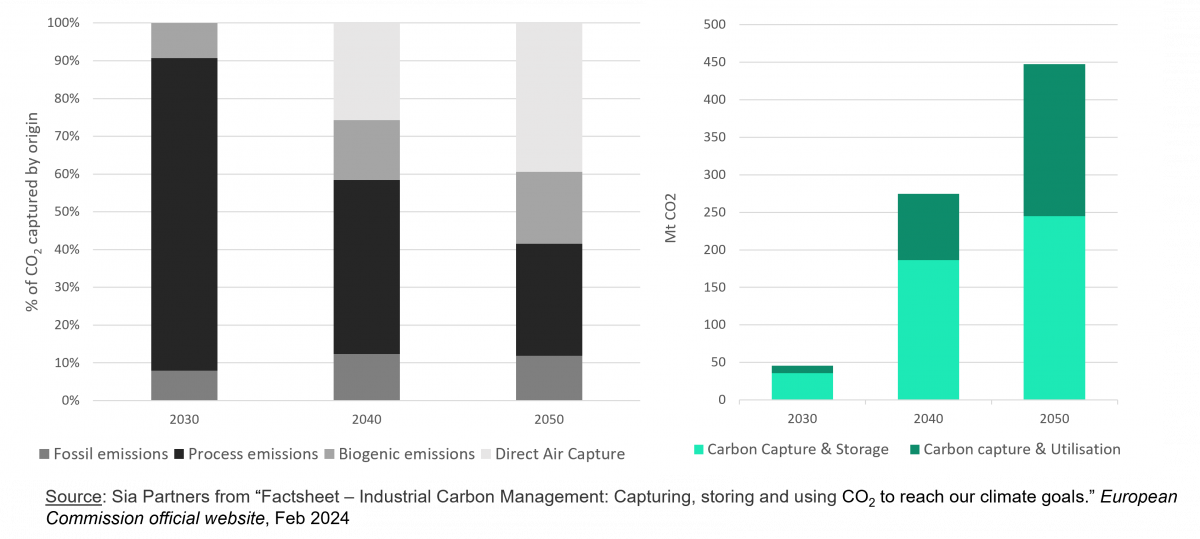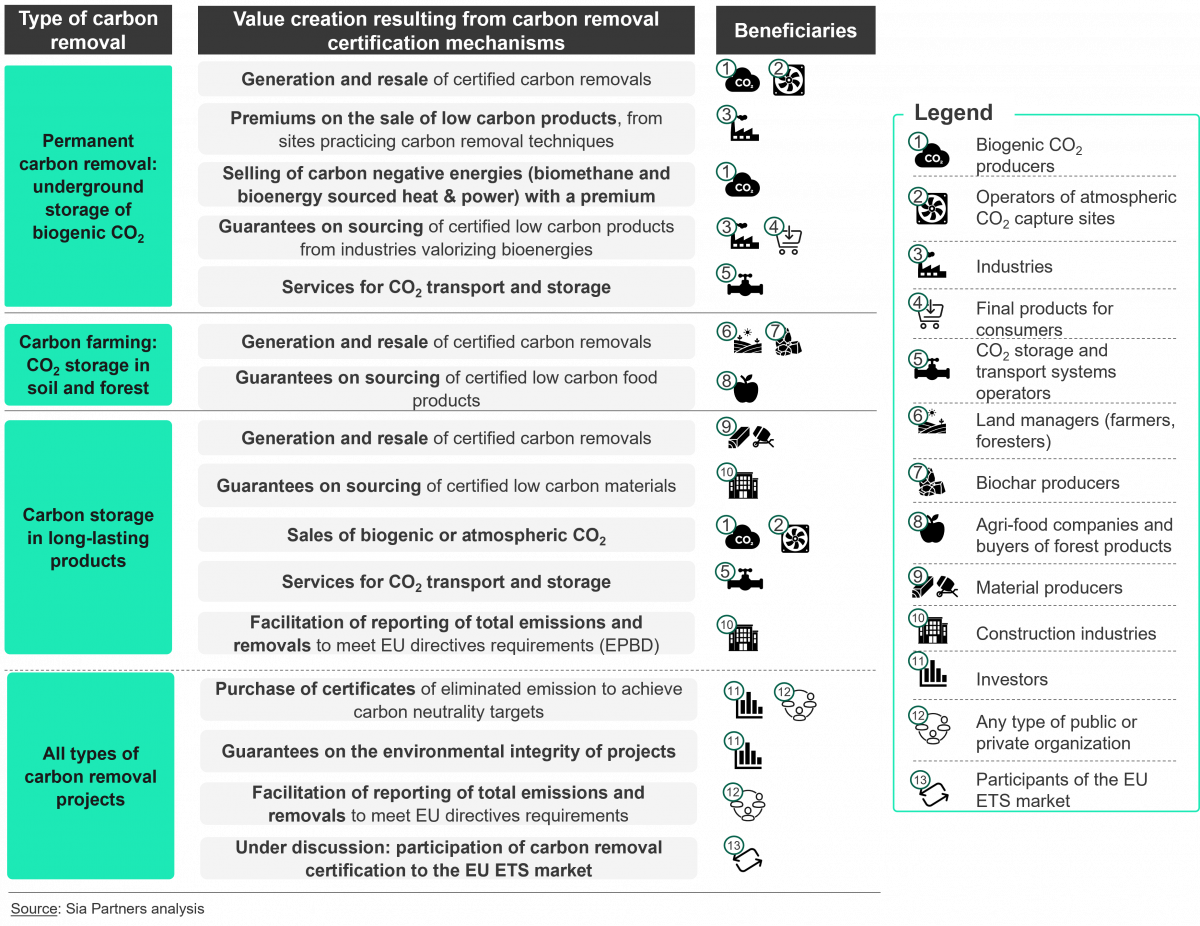Fortune 100 response to DE&I pressures - Q2 2025

Paving the way for the acceleration of carbon-negative project development.

To meet its ambitious plan to become carbon neutral in 2050, the EU has adopted a Carbon Removal Certification Framework (CRCF) in order to pave the way for the development of carbon removal solutions. This common framework, certifying high-quality carbon removals, was voted in on April 10, 2024 by the European Parliament.
“Business models linked to carbon removal are still under-considered by the market players which could be involved,” according to Charlotte de Lorgeril, Partner, Energy, Environment & Utilities at Sia Partners, “The future European regulations may unlock some of the main business models pain points”.
As time ticks on, the European Union (EU) is actively seeking solutions to address the urgent challenge of climate change, especially by tackling its primary driver: carbon dioxide (CO2) emissions. While the EU only accounts for about 8% of global CO2 emissions, it holds a historical responsibility, being one of the earliest industrialized regions with an industrial revolution that started in the late 18th century. More than two centuries later, the EU is committed to the transition towards carbon neutrality, demonstrating its dedication through several initiatives and regulations.

Main regulatory steps toward carbon neutrality in the European Union.
On February 6, 2024, the EU released one of the latest components of its strategy toward carbon neutrality: the EU’s Industrial Management Strategy. This strategy highlights the need for an accelerated deployment of carbon capture and storage solutions to achieve carbon neutrality by 2050. The strategy outlines specific targets, aiming to capture approximately 280 million tons (mt) of CO2 equivalent by 2040 and 450 mt by 2050. Industry stakeholders state they could capture up to 80 mt of CO2 equivalent per year in Europe by 2030, subject to investment conditions.
The implementation of the carbon removal certification framework will generate new income opportunities for companies actively engaged in removing CO2 from the atmosphere. Furthermore, it will develop new investment opportunities and business models, while effectively advancing climate neutrality objectives.

Projections of the percentage of captured CO2 by origin and quantities, captured and used, or stored, in 2030, 2040 and 2050 in Europe.
After reaching a provisional agreement with the Council, the European parliament has finally adopted this new regulation to establish the first EU-wide voluntary framework to reliably certify high-quality carbon removals. The main objectives of this latest regulation are to accelerate the deployment of verifiable and high-quality carbon removals, encourage industries, farmers, and foresters to adopt effective carbon removal solutions, ensure the EU's capacity to quantify, monitor, and verify carbon removals, counter greenwashing by focusing on high-quality removals and to build trust through reliable removals, and stimulate a wide variety of results-based financing options from private or public sources.
The final plenary vote in the European Parliament took place on April 10, 2024, so the agreement will enter into force by 2024. Concurrently with the legislative process, work has begun on detailed methodologies for various carbon removal activities, which will be defined in separate delegated acts by the Commission.
By 2026, the Commission is requested to assess the possibility of including permanent carbon removals in the EU Emissions Trading System (EU ETS), and eventually present a legislative proposal and an impact assessment.

Value creation opportunities resulting from the CRCF.
For instance, farmers, land managers or traditional biogenic CO2 players will now be able to earn and trade carbon removal certifications with industries aiming for carbon neutrality. The CRCF will raise the quality of the carbon removal credits exchanged in voluntary carbon markets, and open doors for investments in projects that excel in removing carbon or achieving negative emissions, as investors will be able to better compare carbon removal efforts using the CRCF quality criteria and certification methodologies.
For companies seeking to communicate transparently about their environmental footprint, the carbon removal units could be used as a tool to facilitate the reporting of total emissions and removals and for neutralizing residual emission in the value chain for the ESRS E1 climate reporting standard adopted under the Corporate Sustainability Reporting Directive (CRSD). Moreover, carbon removal units could also be used to meet the requirements of the proposed Green Claims Directive (GCD) that establishes requirements for communicating corporate environmental claims to consumers, to prevent greenwashing.
Furthermore, through the CRCF certification methodology for carbon storage in products, building owners will be able to provide tangible evidence of their structures’ carbon storage capacities in their building’s Energy Performance Certificate (EPC), in compliance with the revised Energy Performance of Buildings Directive (EPBD) that now allows the declaration of the carbon storage capacity of the structure on the EPC.
Livestock emission reductions are not eligible for certification under the CRCF but could be included in the scope of carbon farming by 2026, as the Commission intends to assess the feasibility of certifying activities that reduce agricultural emissions from the management of livestock.
Various business models will spring up to reward carbon removal efforts. Thanks to this EU certification, businesses and organizations will be able to apply for funding from EU programs such as the Common Agricultural Policy, the Innovation Fund or State aid schemes by Member states using the CRCF quality criteria. Plus, companies may offer incentives to their suppliers for providing additional carbon removal, backed by reliable certification.
Beyond its role in standardizing carbon accounting, upcoming EU regulations are thought to institute rigorous procedures for quantifying, monitoring, and verifying carbon removal activities. Such measures are pivotal in steering the EU towards its ambitious goal of achieving carbon neutrality by 2050 and beyond, to remove past emissions from the atmosphere and reduce CO2 intensity.
In the emerging landscape of carbon removal initiatives, we have seen several calls made by public and private actors to regulate these initiatives of carbon removals after some carbon removals practices were revealed to be completely inefficient, despite being certified by a well-known certifier and used by global corporations to offset their emissions. Recent analysis conducted by journalists concluded that 90% of the rainforest offset credits that were certified shouldn’t have been.
What is at stake for the sector is the transparency and trust in the information that is communicated about efficiency and effectiveness of removal processes. The main benefit of setting up such a common framework for carbon removals certification is to mitigate the risk of greenwashing by carbon removal services providers, and to build trust for buyers by focusing on trustworthy removals.
In the same way, the establishment of common standards will enable fair competition among players, which is crucial in the innovative and competitive field of Direct Air Capture technologies. This framework not only levels the playing field but also encourages the adoption of more effective carbon removal solutions, and finally tackles climate change in the most efficient way.
By ensuring qualitative and transparent information for potential customers, this regulatory framework will encourage the emergence of new economic, commercial and financial opportunities. For the “traditional” carbon removal players such as farmers, land managers, and foresters contributing to the EU climate goals with additional removal capacities, the CRCF can unlock additional revenue streams. For innovative players that are developing technical solutions such as Direct Air Capture, the introduction of the CRCF will bolster their business models and lead to diverse financing mechanisms from private and public entities.
The regulation on carbon removals establishes distinctions between carbon removal and storage processes, many of which can be certified under the proposal:
Carbon can be stored permanently through solutions such as bioenergy with carbon capture and storage (BECCS) or direct air capture with carbon capture and storage (DACCS).
Additionally, carbon can be naturally stored on land through activities that enhance carbon capture in soils and forests or reduce carbon emissions from soils into the atmosphere (e.g., peatland restoration).
Lastly, atmospheric carbon can be captured by trees or industrial technologies and stored in long-lasting products and materials, such as wood-based construction.
The European Commission's proposal does not cover the capture of fossil carbon for storage and utilization (CCUS).
According to this proposal, carbon removal activities must meet four QUALITY criteria:
QUantification: Carbon removal activities must be accurately measured, and provide unambiguous carbon removal benefits. The "net carbon removal benefit" must be quantified robustly and precisely.
Additionality: Carbon removal activities must exceed standard practices and legal requirements. The preferred method to demonstrate additionality is to define a "standardized" baseline reflecting standard practices and regulatory and market conditions. To ensure long-term ambition, the standardized baseline should be periodically updated.
Long-term storage: Carbon removal activities must ensure that the removed carbon is stored for as long as possible, and the risk of carbon release must be minimized. Certificates will clearly account for the duration of carbon storage and distinguish permanent storage from temporary and long-term storage. For instance, in the case of carbon storage in products, the storage must respect a monitoring period of at least 35 years to benefit from the certification scheme. After 35 years, if the monitoring is not re-conducted by operators, the carbon captured and stored should be assumed to have been released into the atmosphere.
SustainabiliTY: Carbon removal activities must have a neutral impact on, or generate co-benefits for, other environmental objectives such as biodiversity, climate change adaptation, greenhouse gas emission reduction, water quality, zero pollution, or the circular economy. The Commission will prioritize the development of certification methodologies tailored to carbon farming activities that provide significant biodiversity co-benefits.
To get the carbon removal certification, operators of carbon removal activities will have to apply to a public or private certification scheme that is approved by the EU Commission. Independent certification bodies will evaluate the carbon removals activities to check if they comply with the certification criteria. If approved, then certificates of compliance, valid until the next re-certification audit (typically every year, or at least every 5 years), and carbon removals units will be issued. Moreover, the audit summaries and certificates of compliance will be recorded in public registries managed by certification schemes until the establishment of the Union-wide CRCF registry.
To minimize monitoring and certification costs, the monitoring shall be a combination of remote sensing or modelling and on-site measurements according to rules set out in the EU certification methodologies. Furthermore, group auditing will be allowed for groups of operators (e.g. small farmers and forest holders), and the regulation will set out standardized baselines, and promote synergies with other EU information systems, such as the Land Parcel Information System (LPIS) established under the Common Agricultural Policy (CAP).
Now that the proposal has been adopted by the EU parliament by a large majority of MEPs – 441 MEPs in favor, 139 against and 41 abstained – this new text still needs to be approved by member states within the EU Council. Once adopted by national ministers, the new rules will formally enter into force 20 days later as usual.
Then, the next step for the European Commission will be to frame the implementation of this new legislation through Delegated Acts with the purpose of introducing tailored certification methodologies for the different types of carbon removal activities – carbon farming and storage in products, permanent storage and storage in long-lasting products – based on the work of 70 experts.
These Delegated Acts are also expected to implement third-party verification rules and set-up an EU-Wide registry of carbon removal certificates. This process will also present an opportunity to address issues that may have been raised by NGOs in order to avoid greenwashing practices.
By 2026, the Commission must also assess the possibility of including permanent carbon removals in the EU Emissions Trading System (EU ETS), and eventually present a legislative proposal and an impact assessment of such an inclusion.
“Business models linked to carbon removal are still under-considered by the market players which could be involved.”, according to Charlotte de Lorgeril, Partners Energy, Environment & utilities at Sia Partners. “There are several reasons for this: the complexity of the business models, low awareness, fear of being accused of greenwashing, and lack of confidence in certification systems. The future European regulations could provide a response to some of these issues.”
“The regulation defines a set of best practices that could inspire law makers and labels in other geographies.”
For Yann Lesestre, Manager, Energy, Environment & Utilities at Sia Partners, "Some carbon removal projects will require structuring entirely new value chains, involving CO2 producers, transporters and potentially CO2 consumers. Strong, long-term partnerships between all these players and the buyers of the carbon removal certificates will be a means of de-risking the projects. This approach will also be key to increase buyers' confidence in the quality of the certificates purchased."